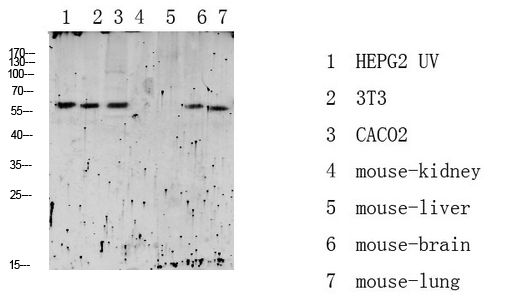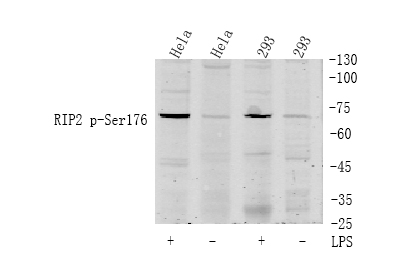RIP2 Polyclonal Antibody
- Catalog No.:YT4147
- Applications:WB;IHC;IF;ELISA
- Reactivity:Human;Mouse
- Target:
- RIP2
- Fields:
- >>NOD-like receptor signaling pathway;>>Neurotrophin signaling pathway;>>Shigellosis;>>Salmonella infection;>>Tuberculosis
- Gene Name:
- RIPK2
- Protein Name:
- Receptor-interacting serine/threonine-protein kinase 2
- Human Gene Id:
- 8767
- Human Swiss Prot No:
- O43353
- Mouse Gene Id:
- 192656
- Mouse Swiss Prot No:
- P58801
- Immunogen:
- The antiserum was produced against synthesized peptide derived from human RIPK2. AA range:146-195
- Specificity:
- RIP2 Polyclonal Antibody detects endogenous levels of RIP2 protein.
- Formulation:
- Liquid in PBS containing 50% glycerol, 0.5% BSA and 0.02% sodium azide.
- Source:
- Polyclonal, Rabbit,IgG
- Dilution:
- WB 1:500 - 1:2000. IHC 1:100 - 1:300. ELISA: 1:40000.. IF 1:50-200
- Purification:
- The antibody was affinity-purified from rabbit antiserum by affinity-chromatography using epitope-specific immunogen.
- Concentration:
- 1 mg/ml
- Storage Stability:
- -15°C to -25°C/1 year(Do not lower than -25°C)
- Other Name:
- RIPK2;CARDIAK;RICK;RIP2;Receptor-interacting serine/threonine-protein kinase 2;CARD-containing interleukin-1 beta-converting enzyme-associated kinase;CARD-containing IL-1 beta ICE-kinase;RIP-like-interacting CLARP kinase;Receptor-in
- Observed Band(KD):
- 61kD
- Background:
- This gene encodes a member of the receptor-interacting protein (RIP) family of serine/threonine protein kinases. The encoded protein contains a C-terminal caspase activation and recruitment domain (CARD), and is a component of signaling complexes in both the innate and adaptive immune pathways. It is a potent activator of NF-kappaB and inducer of apoptosis in response to various stimuli. [provided by RefSeq, Jul 2008],
- Function:
- catalytic activity:ATP + a protein = ADP + a phosphoprotein.,function:Activates pro-caspase-1 and pro-caspase-8. Potentiates CASP8-mediated apoptosis. Activates NF-kappa-B.,PTM:Autophosphorylated. Phosphorylated upon DNA damage, probably by ATM or ATR.,similarity:Belongs to the protein kinase superfamily. TKL Ser/Thr protein kinase family.,similarity:Contains 1 CARD domain.,similarity:Contains 1 protein kinase domain.,subunit:Binds to CFLAR/CLARP and CASP1 via their CARD domains. Binds to BIRC3/c-IAP1 and BIRC2/c-IAP2, TRAF1, TRAF2, TRAF5 and TRAF6. May be a component of both the TNFRSF1A and TNRFSF5/CD40 receptor complex.,tissue specificity:Detected in heart, brain, placenta, lung, peripheral blood leukocytes, spleen, kidney, testis, prostate, pancreas and lymph node.,
- Subcellular Location:
- Cytoplasm .
- Expression:
- Detected in heart, brain, placenta, lung, peripheral blood leukocytes, spleen, kidney, testis, prostate, pancreas and lymph node.
- June 19-2018
- WESTERN IMMUNOBLOTTING PROTOCOL
- June 19-2018
- IMMUNOHISTOCHEMISTRY-PARAFFIN PROTOCOL
- June 19-2018
- IMMUNOFLUORESCENCE PROTOCOL
- September 08-2020
- FLOW-CYTOMEYRT-PROTOCOL
- May 20-2022
- Cell-Based ELISA│解您多样本WB检测之困扰
- July 13-2018
- CELL-BASED-ELISA-PROTOCOL-FOR-ACETYL-PROTEIN
- July 13-2018
- CELL-BASED-ELISA-PROTOCOL-FOR-PHOSPHO-PROTEIN
- July 13-2018
- Antibody-FAQs
- Products Images
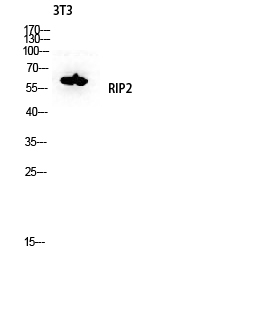
- Western blot analysis of 3T3 lysis using RIP2 antibody. Antibody was diluted at 1:500
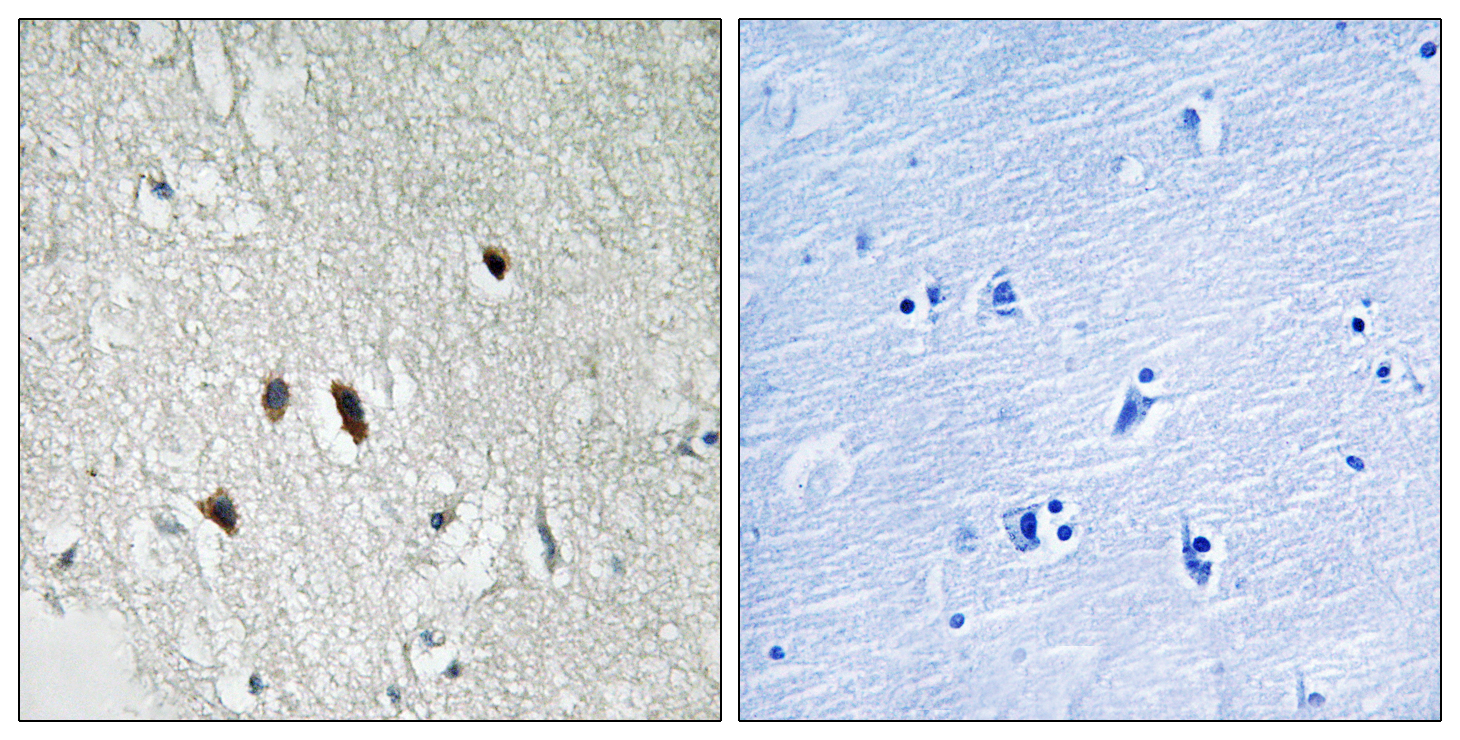
- Immunohistochemistry analysis of paraffin-embedded human brain tissue, using RIPK2 Antibody. The picture on the right is blocked with the synthesized peptide.
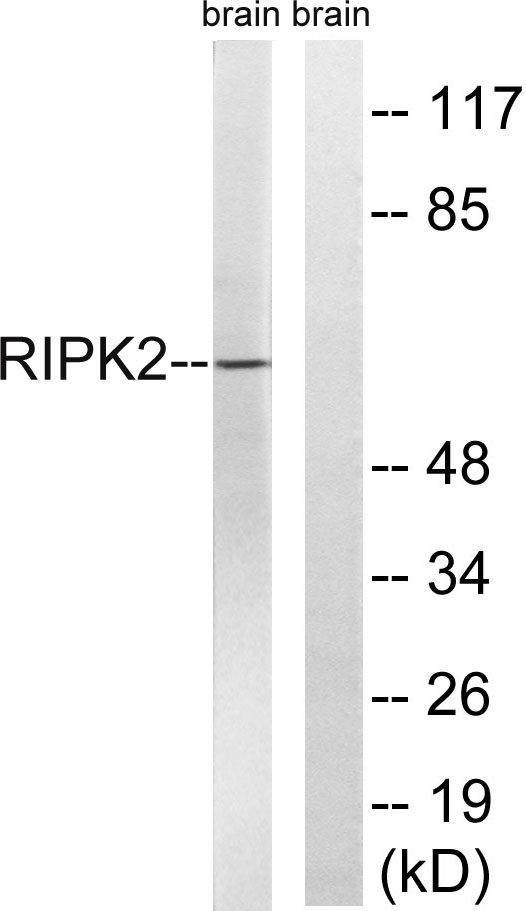
- Western blot analysis of lysates from rat brain cells, using RIPK2 Antibody. The lane on the right is blocked with the synthesized peptide.
